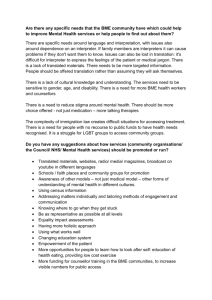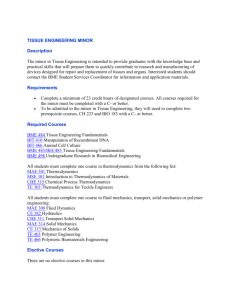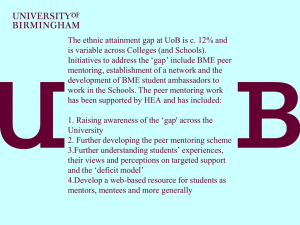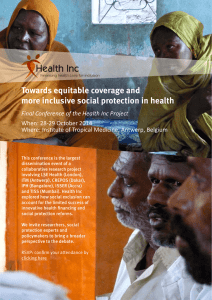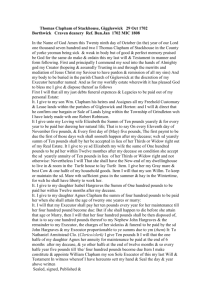NANOTI Kickoff Meeting Minutes
advertisement
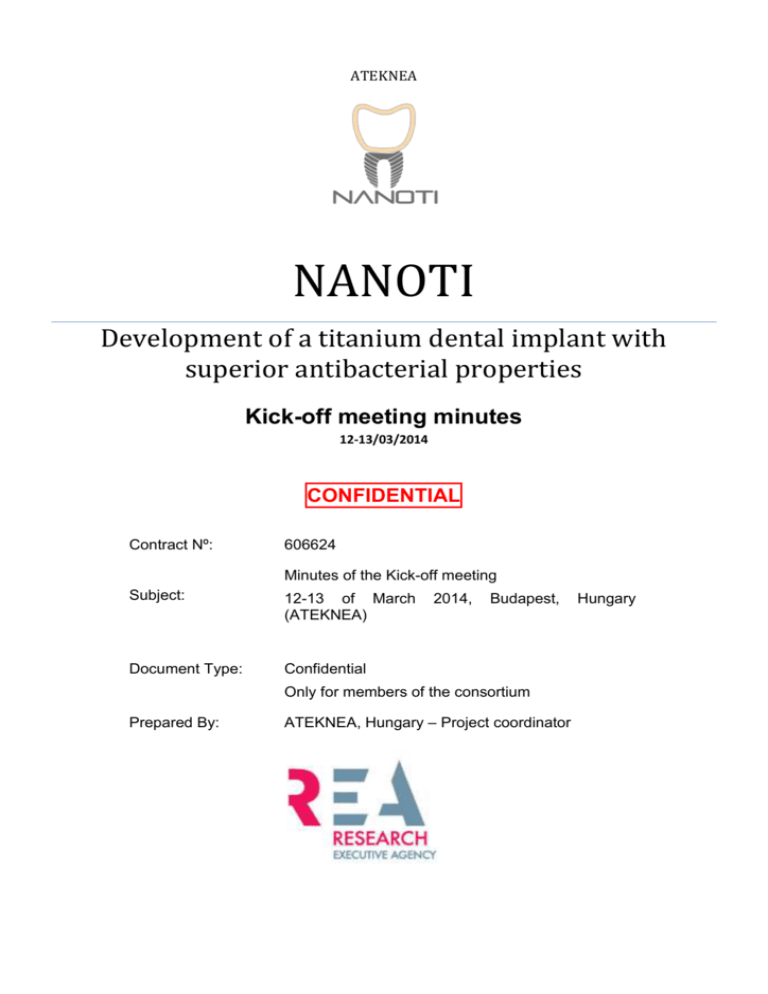
ATEKNEA NANOTI Development of a titanium dental implant with superior antibacterial properties Kick-off meeting minutes 12-13/03/2014 CONFIDENTIAL Contract Nº: 606624 Minutes of the Kick-off meeting Subject: 12-13 of March (ATEKNEA) Document Type: Confidential 2014, Budapest, Only for members of the consortium Prepared By: ATEKNEA, Hungary – Project coordinator Hungary Prepared by: Technical coordinator of the project: Company Acronym Responsible Person ATEKNEA, HUN Balazs Ring Name: Balazs Ring Organization: ATEKNEA Solutions Hungary LLC. Phone: +36 1 787 4024 x 338 Fax: +36 1 787 4390 Email: balazs.ring@ateknea.com Project website: www.nanoti.eu Document History: Issue Date Version 18.03.14 v0.1 25.03.14 V1 Changes / Reasons of Issue Made by First Draft Balazs Ring Final Copyright © Copyright 2014 NANOTI Consortium This document has been produced within the scope of the NANOTI Project and is confidential to the participants of the project. The utilization and release of this document is subject to the conditions of the contract within the 7th Framework Programme, grant agreement no. 606624. Contents 1 Meeting Modalities ............................................................................................................................... 3 2 Attendees .............................................................................................................................................. 3 3 Agenda .................................................................................................................................................. 4 4 Minutes ................................................................................................................................................. 5 4.1 Welcome by the Coordinator ........................................................................................................ 5 4.2 Technical session for the RTD partners ...................................... Error! Bookmark not defined. 4.3 SMEs join to the meeting ............................................................ Error! Bookmark not defined. 4.4 Non-technnical tasks ..................................................................................................................... 7 4.5 Wrap-up session ............................................................................................................................ 9 1 Meeting Modalities The Kick-off meeting was hosted by ATEKNEA in Budapest, Hungary (H-1119 Budapest, Tétényi u. 93.). Some of the partners joined via Skype conference. 2 Attendees NANOTI Grant Agreement No 606624 Started: 2014-02-01 Duration: 24 months Status: On-going project Contact: nanoti@ateknea.hu The project supported by: Venue: meeting Name Organisation Role Initials 1 Miklós Budai ATEKNEA Solutions RTD MB 2 Attila Ágoston ATEKNEA Solutions RTD AA 3 Patrícia Mérei ATEKNEA Solutions RTD PM 4 Orsolya Korda ATEKNEA Solutions RTD OK 5 Balázs Ring ATEKNEA Solutions RTD BR 6 Attila Wootsch ATEKNEA Solutions RTD AW 7 Miklós Weszl ITM Hungary Kft. SME MW 8 Krisztián Tóth ITM Hungary Kft. SME KT ProTIP SAS SME EV TU Dresden RTD DS TU Dresden RTD CW 9 10 11 Nihal Engin Vrana (skype) Dieter Scharnweber (skype) Cornelia WolfBrandstetter (skype) 12 Eszter Bognár BME RTD EB 13 Attila Terdik BME RTD AT 14 Péter Nagy BME RTD PN Apologized: Zoltan Rakonczay- USZ Renata Giliene - MEDGRUPE 3 Agenda Wednesday 12th of March 2014 – Technical Meeting 14:00 – 14:30 Welcome by the Coordinator Short overview of the Project 14:30 – 16:30 Project overview Present the Technical objectives, Workplan and Milestones Technical discussion and brainstorming System Specification Opened questions and risks Thursday 13th of March 2014 – General Kick-off Meeting 9:30 – 9:45 Welcome by the coordinator Short overview of the project, General objectives 9:45 – 10:45 Introduction of partners 10:45 – 11:00 Coffee break 11:00 – 11:30 Project overview 11:30 – 12:30 Present Technical objectives, Workplan, Milestones and Deliverables, Role of partners Financial and administrative matters 12:30 – 13:15 Lunch 13:15 – 14:15 Discussion of next meetings, exploitation, dissemination and IPR issues, Introduction to the Research for the benefit of SMEs scheme, Grant Agreement, Consortium Agreement, Financial matters (reporting, cost justification) Exploitation, dissemination possibilities (all partners each), Exploitation Manager’s tasks, IPR protection 14:15 – 14:30 Coffee break 14:30 – 15:30 Overview of next steps Excerpt from the Technical Meeting, General tasks for the next 6 months, Detailed discussion of the tasks for the first 3 months Closing of Meeting Remind the next 3 months to DO and the urgent deliverables 15:30 – 15:45 4 Minutes (12th March) 4.1 Welcome by the Coordinator BR: Welcome speech and agenda introduction 4.2 Project Status update The project started on the 1st of February. Unfotunately,AVINENT decided to withdraw from the project. The new partner to take over AVINENT’s role called ProTIP SAS. It’s a French company situated in Strassburg having business activity in titanium based medical implant development. The new company is already validated and the DoW modification has been accepted by the Officer. 4.3 Project Overview and discussion 4.3.1 General overview BR introduced the problems with current dental implants and the Nanoti solution for them. He made a short overview of the consortium, and of the overall work plan. 4.3.2 Technical objectives, Workplan and Milestones BR gave a short overview on the technical objectives, the work packages, the gantt chart and the milestones of the project. 4.3.3 Technical discussion on the system specification Implant geometry for the studies Questions and Answers EB: What geometry should we use for technology development? Disk-like geometry was planned for invitro studies and mini screw-like implants were planned for in vivo studies. (Cell adhesion and proliferation tests should be perfomed on flat surface) KT: ITM would prefer implant geometries from the very beginning. Scientific reasons will be introduced by WM tomorrow. DS: For in-vitro experiments flat surface is required in order to have quantitative results EV: ProTIP can also provide some trachea implants for studies EB: What type of Ti do you use? EV: Grade 2 Chemicals, Technology parameters, hardware Questions and Answers BR: ITM proposed bubbling as an alternative to magnetic stirring for agitation PN: It’s very unuseful as bubbles can stick to the implant surface producing uneven nanosurface BR: Other proposal was to apply some heat treatment EB: It might be useful, but requires special equipment that can maintain inert atmosphere inside the heat chamber. However, it probably has the same effect as electropolishing. BR: How about adding additional tanks to the system for cleaning, rinsing? EB: That would be useful. BR: Considering the implant holder, how would it work? PN: It is based on aPTFE holder plate, implants are fixed with cylindrical rods made of PTFE as well. Electrical connections are done with a wire inside the cylindrical rod that contacts the inner surface of the implant. BR: How about placing the implant in 3D (multiple layers, keeping the same distance from each other) PN: We’ve also thought about that. It could be useful, as more even heat distribution could be achieved. It will be investigated Other issues ProTIP asked for a modification of the agenda for the second day. Detailed project overview has been moved to the morning session, financial and administrative issues have been moved to the afternoon session. 5 Minutes (13th March) 5.1 Welcome by the Coordinator 5.2 Introduction of the partners Company presentation of ITM Hungary Kft. by Miklós Weszl Company presentation of ProTIP SAS by Engin Vrana Introductory presentation of TU Dresden by Dieter Scharnweber Introductory presentation of BME by Attila Terdik Company presentation of ATEKNEA Solutions Hungary by Attila Wootsch As MEDGRUPE and USZ couldn’t join the meeting BR is giving a short overview of them to the partners. 5.3 Project Overview BR presented the business, scientific and technological objectives, and introduced each work package in detail highlighting the deadlines and the role of partners involved. 5.4 Overview of the next steps 5.4.1 Time schedule for the upcoming meetings M3 technical meeting. Proposed date is the 6th of May 2014. Proposed location: Budapest, Hungary. Hosted by ITM TODO: Please check your calendar M6 General meeting Proposed date: first week of July. Proposed location: Budapest, Hungary. Hosted by BME TODO: Proposed dates will be sent by Coordinator, please check your calendar Deliverables BR: Please send all deliverables to the coordinator first preferably two weeks before the final deadline. Coordinator will send it to all partners, they should send their comments within a week. Comments and suggestions will be implemented by the Coordinator and he or she will submit it. 5.4.2 General tasks for the next 6 month BR introduced the upcoming tasks and deliverables for the next 6 months 5.4.3 Detailed discussion of the tasks for the first 3 months BR gave a detailed overview of the upcoming tasks and deliverables for the next 3 months with internal deadlines and responsibilities. 5.4.4 Excerpt from the Technical Meeting & Discussion The main open issues from day 1: Sample geometries has to be finalized (for in-vitro and in-vivo) Important to have both quantitative and qualitative results TUD: in-vitro experiments performed in 3 phases Bacterial adhesion, cell adhesion and proliferation should be performed on flat surfaces to obtain quantitative results In- vivo experiment: what model to use (rat, pig, dog) Two types of implants: soft tissue and bone level implant Skype meeting on system specification between 21-27th March Questions and Answers Sample geometry Partners discussed the possible sample geometry used for in vitro and in-vivo experiments. TUD prefers disc-shape geometries as it provides reliable results for bacterial adhesion experiments, cell adhesion and proliferation studies. ProTIP noted that they could also provide samples. ITM highlighted that from the manufacturers’ point of view it was important to have results that correlate to real life applications, and they were interested in results gained with real implant geometries. Additionally, they noted that the same technology never provided the same results on flat and curled surfaces. BME was fine with either solution, but they would like to know the final decision in order to be able to start working as soon as possible. ITM noted that not much effort should be spent on MSCs studies, rather the attachment of epithelial cells from gingiva should be investigated. Also they would like to incorporate some sort of comparison study (using models from different implant manufacturers) into the experiments. State-of-the-art is Agdoped (silver leaching) implants, ITM would like to compare Nanoti’s performance with it. TUD disagreed with comparative study, as the results wouldn’t be accepted by the scientific community since it didn’t made by third party group. BME proposed to start with flat surface for technology optimization and after that go for implant geometry. Protip agreed. ITM performed a throughout literature search recently, based on the findings they were on a position that there’s no need for extensive in-vitro studies and the study of different surface topography as they had found the key parameters that had to be achieved : polycationic surface. BME stressed that targeting an exact surface specification could impose higher risk, but on the other hand, it was easier for them to develop a pre-specified topography. Considering the biological experiments, Protip highlighted that differentiation studies were also important. ITM underlined that the specified surface topography should be achieved first by BME, and biological studies had to be performed on the final surface. TUD pointed out that homogenous sample surfaces will be required for quantitative biological analyses. Due to time limitation, partners agreed to continue the discussion on the open questions of biological studies via SKYPE in the following week. 5.5 Financial and administrative matters OK introduced the Research for the benefit of the SMEs scheme, she gave a detailed presentation about the grant agreement and the consortium agreement and highlighted the most important financial issues. OK noted that NobelBiacore showed some interest in the project, partners agreed to keep them updated. TUD noted that they are fine with the CA, and they asked about the expected arrival of pre-financing. OK explanained the procedure of transferring the prefinancing highlighting that it can be started as soon as everybody signed the CA. 5.6 Discussion of next meetings, exploitation, dissemination and IPR issues OK gave a detailed presentation about exploitation and dissemination highlighting the tasks of the exploitation manager (ITM). Later IPR related issues were discussed. OK stressed that PUDF was a highly important document and cooperation was needed from all partners. Newsletter should be put together as soon as possible for the companies that showed interest in the project 5.7 Wrap-up session Next meeting 6th May, Budapest Actions required: What Sample geometries has to be finalized (for in-vitro and in-vivo) Important to have both quantitative and qualitative results Who BME, TUD, ITM TUD, ITM When March Finalization of the system spec. & submit the D1.1 and D1.1 ALL March Sample preparation and documentation Website Preparation of mechanical units for the laboratory setup BME April ATEKNEA April BME May Decision on animal model Skype meeting on system specification between 21-27th March June

